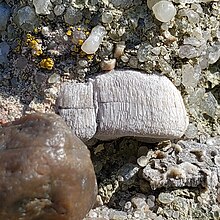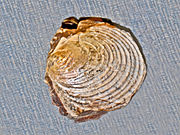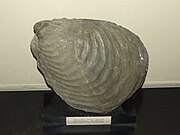Inoceramus
| Inoceramus | |
|---|---|

| |
| Scientific classification | |
| Domain: | Eukaryota |
| Kingdom: | Animalia |
| Phylum: | Mollusca |
| Class: | Bivalvia |
| Order: | Pteriida |
| Family: | †Inoceramidae |
| Genus: | †Inoceramus Sowerby, 1814 |
| Species | |
|
See text | |
Inoceramus (Greek: translation "strong pot") is an
Taxonomy
The taxonomy of the inoceramids is disputed, with genera such as Platyceramus sometimes classified as subgenus within Inoceramus. Also the number of valid species in this genus is disputed.
Description

Inoceramids had thick shells composed of "prisms" of calcite deposited perpendicular to the surface, and unweathered fossils commonly preserve the mother-of-pearl luster the shells had in life.[3] Most species have prominent growth lines which appear as raised semicircles concentric to the growing edge of the shell.[3]
In 1952, the huge specimen of Inoceramus steenstrupi 187 cm long, was found in Qilakitsoq, the Nuussuaq Peninsula, Greenland. This fossil is 83 Ma old, the Upper Santonian or Lower Campanian stage.[4] Paleontologists suggest that the giant size of some species was an adaptation for life in the murky bottom waters, with a correspondingly large gill area that would have allowed the animal to survive in oxygen-deficient waters.[3]
Selected species
- †I. aequicostatus Voronetz, 1937
- †I. albertensis McLearn, 1926
- †I. altifluminis McLearn, 1943
- †I. americanus Walaszczyk & Cobban, 2006
- †I. andinus Wilckens, 1907
- †I. anglicus Woods, 1911
- †I. anilis Pcelinceva, 1962
- †I. anomalus Heine, 1929
- †I. anomiaeformis Feruglio, 1936
- †I. apicalis Woods, 1912
- †I. arvanus Stephenson, 1953
- †I. bellvuensis
- †I. biformis Tuomey, 1854
- †I. brownei Marwick, 1953
- †I. carsoni McCoy, 1865
- †I. comancheanus
- †I. constellatus Woods, 1904
- †I. corpulentus McLearn, 1926
- †I. coulthardi McLearn, 1926
- †I. cuvieri Sowerby, 1814
- †I. dakotensis
- †I. dominguesi Maury, 1930
- †I. dowlingi McLearn, 1931
- †I. dunveganensis McLearn, 1926
- †I. elburzensis Fantini, 1966
- †I. everesti Oppel, 1862
- †I. fibrosus Meek & Hayden, 1857
- †I. formosulus Voronetz, 1937
- †I. fragilis Haal & Meek, 1856
- †I. frechi Flegel, 1905
- †I. galoi Boehm, 1907
- †I. gibbosus
- †I. ginterensis Pergament, 1966
- †I. glacierensis Walaszczyk & Cobban, 2006
- †I. haast Hochstetter, 1863
- †I. howelli White, 1876
- †I. incelebratus Pergament, 1966
- †I. inconditus Marwick, 1953
- †I. kystatymensis Koschelkina, 1960
- †I. lamarcki Parkinson, 1819
- †I. lateris Rossi de Gargia & Camacho, 1965
- †I. mesabiensis Bergquist, 1944
- †I. morii Hayami, 1959
- †I. multiformis Pergament, 1971
- †I. mytiliformis Fantini, 1966
- †I. nipponicus Nagao & Matsumoto, 1939
- †I. perplexus
- †I. pictus
- †I. pontoni McLearn, 1926
- †I. porrectus Voronetz, 1937
- †I. prefragilis Stephenson, 1952
- †I. proximus'' Tuomey, 1854
- †I. pseudolucifer Afitsky, 1967
- †I. quenstedti Pcelinceva, 1933
- †I. robertsoni Walaszczyk & Cobban, 2006
- †I. saskatchewanensis Warren, 1934
- †I. selwyni McLearn, 1926
- †I. sokolovi Walaszczyk & Cobban, 2006
- †I. steenstrupi de Loriol, 1883
- †I. steinmanni Wilckens, 1907
- †I. subdepressus Meek & Hayden, 1861
- †I. tenuirostratus Meek & Hayden, 1862
- †I. triangularis'' Tuomey, 1854
- †I. undabundus Meek & Hayden, 1862
- †I. ussuriensis Voronetz, 1937
Distribution

Species of Inoceramus had a worldwide distribution during the
Gallery
-
Inoceramus from the Cretaceous of South Dakota
-
Inoceramus proximus
-
Inoceramus cuvieri
-
Inoceramus vancouverensis
-
Inoceramus hobetsensis
References
- ^ a b c Inoceramus at Fossilworks.org
- ^ Ward et al., "Ammonite and inoceramid bivalve extinction patterns in Cretaceous/Tertiary boundary sections of the Biscay region (southwestern France, northern Spain)", Geology, 1991
- ^ a b c d Ludvigsen & Beard, 1997, pp. 102–103
- ^ "Verdens største musling". Archived from the original on 18 August 2022.
- ^ Acosta & Ulloa, 2001, p. 41
Bibliography
- Ludvigsen, Rolf; Beard, Graham (1997). West Coast Fossils: A Guide to the Ancient Life of Vancouver Island. pp. 102–103. ISBN 9781550171792.
- Acosta Garay, Jorge; Ulloa Melo, Carlos E (2001). Geología de la Plancha 208 Villeta - 1:100,000 (PDF). INGEOMINAS. pp. 1–84. Archived from the original(PDF) on 24 March 2017. Retrieved 4 April 2017.
Further reading
- Kennedy, W.J.; Kauffman, E.G.; Klinger, H.C. (1973). "Upper Cretaceous Invertebrate Faunas from Durban, South Africa". Geological Society of South Africa Transactions. 76 (2): 95–111.
- Klinger, H.C.; Kennedy, W.J. (1980). "Upper Cretaceous ammonites and inoceramids from the off-shore Alphard Group of South Africa". South African Museum. 82 (7): 293–320.
- Gebhardt, H. (2001). "Inoceramids, Didymotis and ammonites from the Nkalagu Formation type locakity (late Turonian to Coniacian, southern Nigeria): biostratigraphy and palaeoecologic implications". Neues Jahrbuch für Geologie und Paläontologie, Monatshefte. 2001 (4): 193–212. .
- El Qot, G.M. (2006). "Late Cretaceous macrofossils from Sinai, Egypt". Beringeria. 36: 3–163.
- Wild, T. J.; Stilwell, J. D. (2016). "First Cretaceous (Albian) invertebrate fossil assemblage from Batavia Knoll, Perth Abyssal Plain, eastern Indian Ocean: taxonomy and paleoecological significance". Journal of Paleontology. 90 (05): 959–980. .
External links
- "Upper Cretaceous Bivalvia of Alabama". Geological Survey of Alabama. Archived from the original on 16 September 2019.







